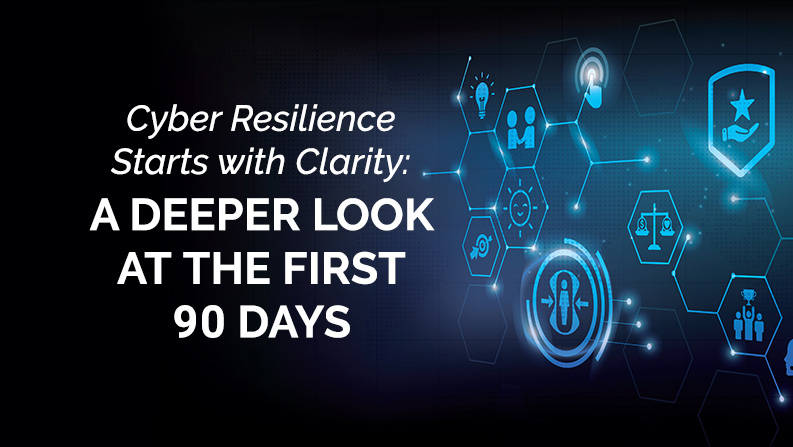Turning Assumptions into Insight with a Focused 3-Step Approach to Assessing Cyber Risk in Your Business
You can’t build resilience on guesswork.
The first 90 days in your cyber resilience journey aren’t about long documents or abstract frameworks—they’re about getting a clear picture of where you are and where the pressure points really live.
This follow-up dives deeper into Phase One of the “Gaps to Gains” Playbook:
Gain Visibility & Identify Gaps.
These first 90 days set the tone for everything that follows. Done well, they help you make smart decisions, prioritize action, and avoid wasting time and money. Here’s how to make them count.
Step 1: Run a Practical Risk Assessment (Week 1–2)
Purpose: Move beyond general awareness and create an inventory of what matters most.
This isn’t a generic compliance checklist. It’s a short, focused exercise that surfaces where risk really intersects with business operations.
What to Do:
- List 5–10 core business systems (ERP, CRM, file storage, vendor portals, accounting, etc.)
- Classify them by function: What happens if this system goes down for 1 hour? 1 day? 1 week?
- Include third-party systems: Supplier portals, integrations, any tools that create dependency.
- Look at shared credentials: Where are logins reused? Who has access that shouldn’t?
Key Outputs:
- A ranked list of systems and services by business impact
- An initial map of risk exposure based on access, backups, and system redundancy
- A short list of “immediate red flags” (e.g., shared credentials for critical systems)
Pro Tip: Document this in a table, not a policy. Visibility comes from simplicity.
Step 2: Talk to Your People (Week 2–3)
Purpose:
Ground your assessment in reality by hearing from the front lines.
You can’t assess resilience from the server room—or a dashboard. You need to understand how real people work, how they respond under pressure, and what they’re worried about.
What to Ask:
- “What system would cause the most disruption if it failed for a day?”
- “If your primary tool went offline, what’s your plan B?”
- “Have you ever seen a suspicious email or system behavior? What did you do?”
- “Who do you contact when you suspect something’s wrong?”
Who to Talk To:
- Operations and customer service – They feel pain first during downtime.
- Finance – For exposure around invoices, payroll, and sensitive data.
- IT (if applicable) – For insights into existing monitoring or assumptions.
- Any admin or team leads – Especially those who’ve created their own workarounds.
Key Outputs:
- A narrative understanding of business process risk
- Identification of gaps in manual fallback plans
- Surfacing of unspoken pain points like “I just use so-and-so’s login” or “We’ve never tested a workaround”
Step 3: Score Your Resilience (Week 4)
Purpose:
Prioritize action by translating visibility into a practical framework.
This isn’t about precision—it’s about direction. The goal is to turn complexity into clarity and create a simple snapshot that your team can rally around.
How to Score:
- For each critical system, rate:
- Red: No backup, high reliance, no fallback
- Yellow: Some mitigation or partial redundancy
- Green: Resilient, tested, and documented
- Create a top 3 risk summary – Where would a disruption do the most damage?
- Identify 1–2 quick wins (e.g., remove shared credentials, set up automated backup alerts)
Key Outputs:
- A one-page “resilience heat map”
- A prioritized list of next actions for the next 90 days
- The foundation for your incident response and business continuity planning
Pro Tip:
Don’t aim for perfect—aim for visibility. This is your reality check, not a compliance report.
The Value of Visibility
Too many businesses skip these steps, assuming someone “has it covered.” But when something breaks—or worse, when someone breaks in—that illusion disappears fast.
The first 90 days of any cyber resilience plan shouldn’t be theoretical. They should deliver insight, alignment, and a focused direction forward.
When you know what you have, how it’s used, and where it breaks—you’re not just reactive. You’re building strategic resilience.
Up next: A deeper dive into how to build lightweight, high-impact continuity and response plans—without overcomplicating the process.
Want to see what your first 90 days could look like in your business?
Let’s start with a short discussion: Book a Free Cyber Resilience Review





